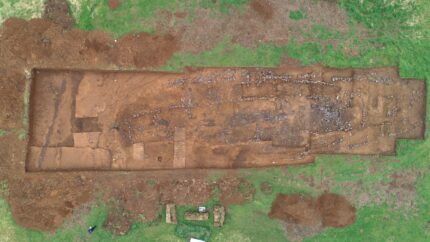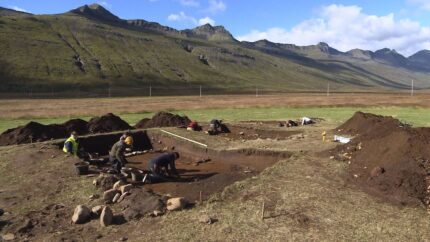 The Landnámabók (the Icelandic Book of Settlement) records that the first Norse settler on Iceland was one Ingólfur Arnarson who left Norway in 874 and built a farmstead on the site what is today Reykjavík. Remains of longhouses from around that time have been discovered under the city, as we know from the high-precision dating made possible by the layer of volcanic tephra ash deposited in 871 A.D. (plus or minus two years margin of error) by an eruption at the Torfajökull volcano field. A site on the Stöðvarfjörður fjord has not one but two structures that significantly predate the tephra ash and the official settlement of Iceland.
The Landnámabók (the Icelandic Book of Settlement) records that the first Norse settler on Iceland was one Ingólfur Arnarson who left Norway in 874 and built a farmstead on the site what is today Reykjavík. Remains of longhouses from around that time have been discovered under the city, as we know from the high-precision dating made possible by the layer of volcanic tephra ash deposited in 871 A.D. (plus or minus two years margin of error) by an eruption at the Torfajökull volcano field. A site on the Stöðvarfjörður fjord has not one but two structures that significantly predate the tephra ash and the official settlement of Iceland.
Archaeological remains were discovered at the Stöð farm by accident in 2003 and the first excavations began in 2015. Since then, archaeologists have found the remains of two structures, both of them under the tephra layer. They are Viking Age longhouses. The most recent one dates to between 860 and 870 and is 103 feet long, conspicuously larger than other early Settlement Era longhouses found in Reykjavík. The one discovered during hotel development in 2015 was 66 feet long.
Excavation leader Bjarni F. Einarsson:
“It is also the richest longhouse ever excavated in Iceland. We have found 92 beads and 29 silver objects, including Roman and Middle-Eastern coins.” The bead horde at Stöð is twice as large as the next two largest found in Iceland combined. In fact, it is one of the very largest ever found at a Viking-Age site in all of Scandinavia.
The older of the two longhouses is even huger at approximately 130 feet long. Radiocarbon analysis of barley grains found in the longhouse layer dates it to around 800 A.D., seven decades before Ingólfur Arnarson set food on Iceland’s shores. The younger farmhouse was built within the collapsed walls of the older one.
Bjarni’s theory is that the older longhouse was a seasonal hunting camp. He believes such camps were operated in other parts of Iceland as well. “We have found several sites in Iceland where we can confirm human presence before the year 874. The site on Aðalstræti in downtown Reykjavík is one. Another is Vogur in Hafnir [Southwest Iceland].”
Seasonal camps would have played a vital role in the settlement of Iceland, extracting valuable resources and thus financing further exploration and settlement. Recent paleoecological research suggests the valuable resource that drew them there was walrus ivory. Walrus ivory was in high demand in Europe in the ninth century, as were the animals’ blubber and hides. It was also valuable: a single walrus tusk was worth the annual wages of one farm worker.
The very name of the farm supports Einarsson’s position. Stöð means camp or base.
The aerial picture appears to show that they have stacked the turfs up to create two sofas 😆